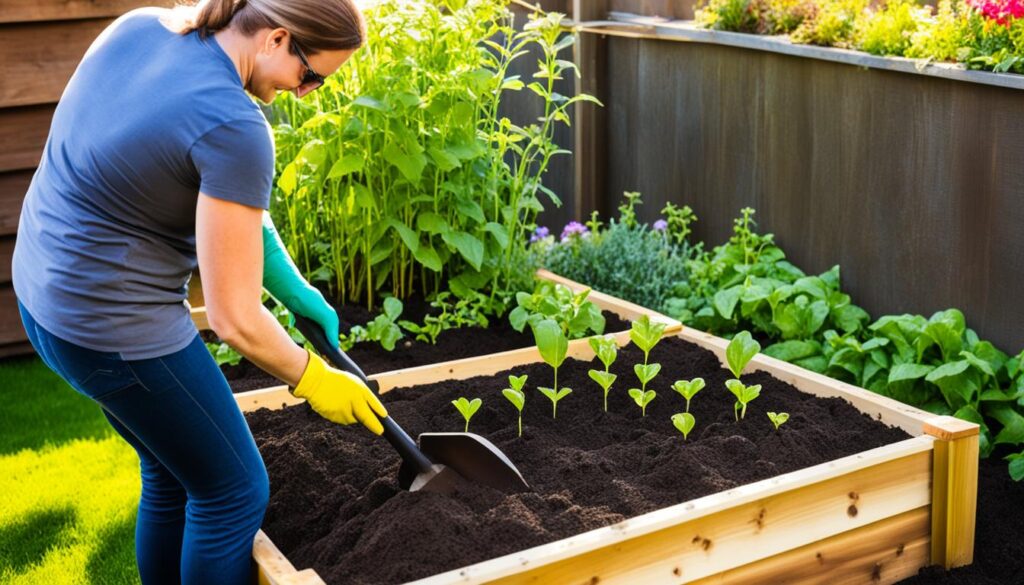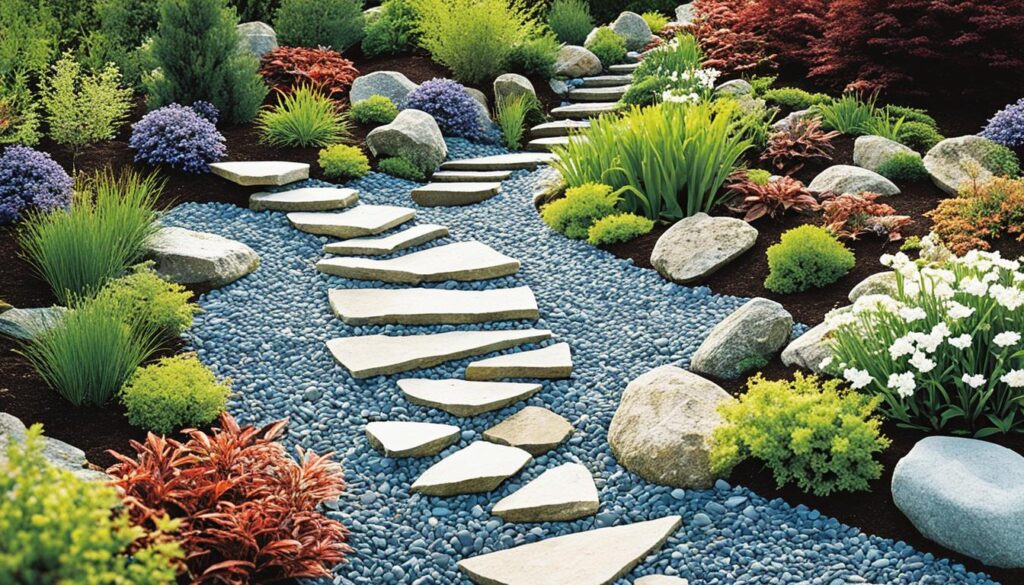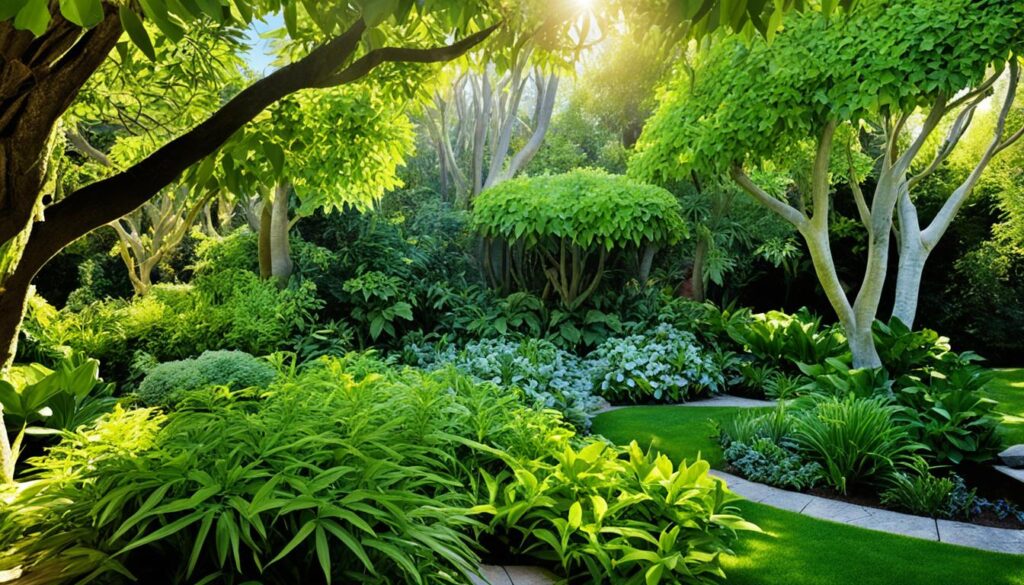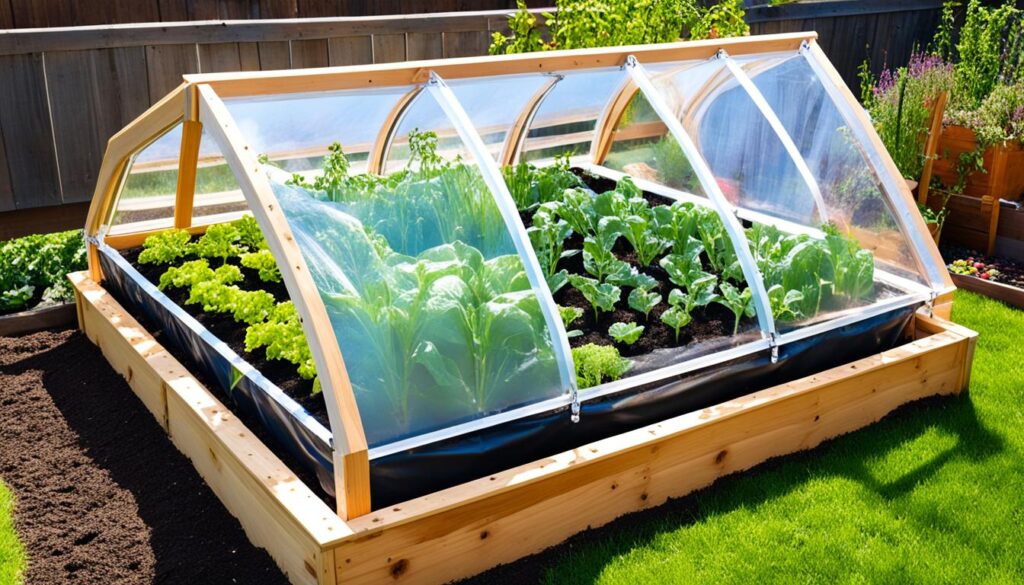Hello, gardening enthusiasts! Today, I want to share with you the incredible benefits of using eggshells in your garden. These humble kitchen scraps can provide a natural and organic boost to your plants, making them thrive in ways you never thought possible.
Eggshells have long been recognized for their impressive qualities, and incorporating them into your gardening routine can have a significant impact on your plants’ health and vitality.
From acting as plant pots for germination to serving as a natural fertilizer, pest deterrent, and composting material, eggshells offer a range of benefits that will revolutionize your gardening experience.
Key Takeaways:
- Eggshells can be used as plant pots for germination.
- They serve as a natural fertilizer, enriching soil with essential nutrients.
- Eggshells act as a deterrent to pests like slugs, snails, and cabbage white butterflies.
- They can be added to compost bins to enrich the soil.
- Eggshell water and powder can be used as nutrient-rich fertilizers for plant growth.
Creating Egg Shell Planters for Seedlings
Growing seedlings in egg shell planters is an easy and eco-friendly way to kickstart your garden. Not only do egg shells provide a natural container, but they also offer high levels of calcium that benefit plant growth. Here’s how you can create your own egg shell planters for seedlings:
- Halve the shells: Carefully crack open the top portion of the egg shells to create small, cup-like containers. Make sure to keep the bottom half intact for stability.
- Rinse them out: Gently rinse the egg shells with water to remove any leftover egg residue. This will prevent any unpleasant odors or the risk of mold.
- Make small drainage holes: Use a thumbtack or small nail to create a few drainage holes at the bottom of each egg shell. This will ensure that excess water can escape, preventing waterlogged soil.
- Fill with seed compost: Fill each egg shell planter with a high-quality seed compost. This will provide the necessary nutrients and support for your seedlings.
- Plant herbs or flowers: Gently sow the seeds of your choice into the compost-filled egg shells. Opt for smaller plants such as herbs or flowers that are well-suited for egg shell planters.
- Transplant when seedlings grow: Once the seedlings have grown and developed a strong root system, it’s time to transplant them into your garden or containers. Bury the eggshell completely in the soil, utilizing its nutrients.
The decomposing eggshell acts as a natural fertilizer, providing additional nutrients to promote healthy plant growth. Plus, the shells gradually break down and become part of the soil, reducing waste and enriching your garden. Give your seedlings a head start with these DIY egg shell planters!
Using Egg Shells as Fertilizer
Crushed eggshells can be a fantastic fertilizer for your outdoor flowers, vegetables, and fruit trees. Not only do they provide essential nutrients, but they also replenish the soil with calcium, which helps moderate acidity levels.
To utilize eggshells as fertilizer, you have a couple of options. First, you can crush the eggshells into a powder and sprinkle them over the soil. Alternatively, you can add the crushed shells directly to the planting holes before placing your plants.
Did You Know? Eggshells can also be transformed into a calcium solution that can be conveniently added to watering cans for easy absorption by plant roots!
Eggshell fertilizer is especially beneficial for outdoor flowers, supplying them with the necessary nutrients for healthy growth and vibrant blooms. For vegetables and fruit trees, the calcium-rich properties of eggshells support overall plant health and contribute to the development of strong, robust produce.
If you’re unsure about the appropriate amount of eggshell fertilizer to use, it’s always best to start with a small amount and gradually increase the quantity as needed. Remember, it’s essential to maintain a balanced nutrient level in the soil to ensure optimal plant growth.
Benefits of Eggshell Fertilizer:
- Provides essential nutrients for outdoor flowers, vegetables, and fruit trees
- Replenishes soil with calcium, moderating acidity levels
- Promotes healthy plant growth and vibrant blooms
So why not give eggshell fertilizer a try in your garden? It’s a natural and cost-effective solution that can help your plants thrive while reducing waste.
| Plants | Recommended Application |
|---|---|
| Outdoor Flowers | 0.5-1 cup per flower bed |
| Vegetables | 1-2 tablespoons per plant |
| Fruit Trees | 2-4 tablespoons per tree |
Egg Shells as Pest Deterrent
When it comes to protecting your garden from pests, organic pest control methods are not only effective but also environmentally friendly. One such method that you can try is using egg shells as a natural deterrent.
As I mentioned earlier, egg shells act like shards of glass, creating an uncomfortable surface for pests to crawl over. This is particularly effective in deterring slugs, snails, and other crawling pests that can wreak havoc on your plants. The sharp edges of the egg shells pose a barrier that these pests prefer to avoid.
Additionally, the white sheen of the egg shells can also deter cabbage white butterflies. The reflective surface confuses the butterflies and makes them less likely to lay their eggs on your plants, preventing damage from hungry caterpillars.
But that’s not all. Did you know that egg shells can even keep cats out of your garden beds? Cats dislike walking on noisy, sticky, or sharp objects, so the texture of crushed egg shells can deter them from using your garden as a litter tray. This can be particularly helpful if you have precious seedlings or delicate plants that you want to protect.
Remember, to make the most of egg shells as a pest deterrent, crush them into small pieces and sprinkle them around the base of your plants or create a barrier around your garden beds. This will create an effective and natural barrier against unwanted visitors.
| Plants | Pests |
|---|---|
| Vegetables (e.g., lettuce, cabbage) | Slugs, snails, crawling pests |
| Herbs (e.g., basil, parsley) | Snails, crawling pests |
| Flowers (e.g., marigolds, petunias) | Slugs, snails, cabbage white butterflies |
This table shows some common plants and the pests that can be deterred using egg shells as a natural pest control method. However, it’s important to note that while egg shells can be effective, they may not provide complete protection against all pests. Consider combining egg shells with other pest control measures for a comprehensive approach.
Egg Shells in Composting
When it comes to composting, don’t overlook the benefits of adding egg shells to your compost bin. As they break down over time, egg shells provide a valuable source of essential nutrients such as calcium, minerals, and proteins. By incorporating egg shells into your compost, you can enrich the soil and aid in building strong cell walls for your plants.
To prepare egg shells for composting, start by washing them thoroughly to remove any residues. Once clean, crush the shells into a powder using a pestle and mortar or a blender. This will facilitate the decomposition process and help the egg shell pieces blend seamlessly with the compost and mulch.
The Nutritional Benefits of Egg Shells in Compost
Egg shells offer a rich source of calcium, which is essential for promoting healthy plant growth. Calcium plays a vital role in supporting cell division, enzyme activity, and nutrient absorption in plants. By introducing egg shells into your compost pile, you not only increase calcium availability but also provide additional minerals and proteins that contribute to overall plant health.
“Adding egg shells to your compost can improve the nutrient content of the resulting compost, making it a valuable addition to your garden.”
When composting, it’s important to maintain the right balance of organic materials. Egg shells, with their calcium-rich composition, make an excellent addition to the mix. Remember to crush the shells into small pieces to ensure they decompose efficiently and distribute evenly throughout the compost heap.
| Benefits of Egg Shells in Compost | How to Use |
|---|---|
| Supply essential nutrients | Crush and mix with other organic materials in the compost pile |
| Enhance calcium availability | Break the shells into small pieces to aid decomposition |
| Promote healthy plant growth | Ensure the shells are clean and free of residues |
Composting is a sustainable practice that helps reduce waste and minimize our environmental footprint. By adding egg shells to your compost, you not only divert organic materials from landfills but also create nutrient-rich soil amendments for your garden. So don’t let those egg shells go to waste; let them work their magic by becoming an integral part of your composting routine.

Eggshell Water as Fertilizer
In my quest for nutrient-rich and cost-effective fertilizers, I discovered the hidden potential of eggshells. Not only do they add a touch of sustainability to my gardening practices, but they also provide a wealth of benefits for plant growth. One method that caught my attention is the use of eggshell water as fertilizer.
When I first learned about eggshell water, I was intrigued by its potential to nurture plants with the essential nutrients they need. This natural fertilizer is rich in calcium carbonate, a compound that plays a crucial role in the growth and development of plants.
Eggshell water offers an incredible advantage in regulating the pH level of the soil, making it more alkaline. This is particularly beneficial for plants that thrive in low-acidity environments. By using eggshell water, I can create the ideal conditions for these plants to flourish and reach their full potential.
One of the notable benefits of eggshell water is its ability to prevent blossom-end rot in fruit-bearing plants. Blossom-end rot is a common calcium deficiency disorder that affects the quality and yield of fruits. By providing a calcium-rich solution, eggshell water ensures that the plants receive the necessary nutrients to prevent this condition and produce healthy, bountiful harvests.
If you’re wondering how to make eggshell water, let me simplify the process for you. Begin by collecting clean and dry eggshells. Boil them in water for about 10 minutes to extract the calcium carbonate. Allow the mixture to cool before straining out the shells. The resulting nutrient-rich liquid is now ready to be used as fertilizer for your plants.
By incorporating eggshell water into my gardening routine, I have witnessed remarkable improvements in the growth and vitality of my plants. From vegetables to flowers, they all seem to respond positively to this calcium-rich elixir.
If you’re seeking a sustainable and effective way to nourish your plants, I highly recommend giving eggshell water a try. Not only will you be reducing waste by repurposing eggshells, but you’ll also be providing your plants with the nutrients they need to thrive.
Making Eggshell Water and Powder
If you’re looking for a simple and effective way to provide your garden plants with a calcium boost, making eggshell water and powder is a fantastic homemade fertilizer option. Calcium carbonate, found in eggshells, can greatly benefit the growth and health of your garden plants. Here’s how you can create eggshell water and powder:
Making Eggshell Water
- Boil a gallon of water in a large pot.
- Add clean and dry eggshells to the boiling water.
- Let the eggshells simmer in the water for about 5 minutes.
- Remove the pot from heat and allow the mixture to cool.
- Once cool, strain out the eggshells, leaving behind the milky-looking water.
- Pour the eggshell water directly onto the soil around your garden plants.

This nutrient-rich eggshell water will provide your plants with a calcium boost, promoting strong and healthy growth. It’s an easy and cost-effective way to enhance your garden’s nutrient content.
Making Eggshell Powder
- Collect clean and dry eggshells.
- Crush the eggshells into small pieces.
- Transfer the crushed eggshells into a food processor or blender.
- Pulse the eggshells until they turn into a fine powder.
- Sprinkle the eggshell powder onto the soil before planting your garden plants.
The crushed eggshell powder will slowly release calcium as it breaks down, providing a long-lasting nutritional source for your plants. It’s a great way to ensure your garden soil remains rich in essential nutrients.
By making eggshell water and powder, you can easily create a homemade fertilizer using calcium-rich eggshells. Your garden plants will thank you with vibrant growth and fruitful yields!
Eggshells In Vegetable Gardening
When it comes to vegetable gardening, incorporating eggshells can bring significant benefits to your plants. Not only are eggshells a natural and sustainable resource, but they also provide essential nutrients that promote healthy growth and development.
Tomatoes, peppers, and aubergines are just a few examples of vegetables that can greatly benefit from the inclusion of eggshells in the soil. These nutrient-rich shells not only provide essential calcium but also strengthen the roots of these plants, ensuring sturdy growth and increased yield.
But it’s not just vegetables that benefit from the use of eggshells. Other plants such as roses, hydrangeas, spider plants, ferns, and ivy also thrive when supplemented with the nutrients found in eggshells. Incorporating eggshells into the soil of your flower beds or plant containers can help prevent calcium deficiency and support the overall health of these plants.
Here is an example of how you can use eggshells in your vegetable garden:
- Collect and rinse eggshells after use.
- Allow the eggshells to dry completely.
- Crush the eggshells into small pieces or grind them into a fine powder using a mortar and pestle or a food processor. This will help with their decomposition and nutrient release.
- Work the crushed eggshells into the soil around your vegetables, ensuring they are evenly distributed.
- Water your plants as usual, allowing the nutrients from the eggshells to slowly release into the soil.
By incorporating eggshells into your vegetable garden, you are not only providing a natural source of nutrients, but you are also reducing waste and creating a more sustainable garden environment.
Remember, nature has provided us with valuable resources like eggshells, and it’s important to harness their potential to nourish and support the growth of our plants.
So why not give it a try? Start saving those eggshells and watch your vegetable garden flourish!
| Vegetables | Benefits of Eggshells |
|---|---|
| Tomatoes | Strengthen roots and prevent blossom end rot |
| Peppers | Enhance root development and promote sturdy growth |
| Aubergines | Provide essential calcium for healthy fruit production |
Eggshells in Compost and Gardening
I’ve always been passionate about finding eco-friendly ways to reduce waste and make a positive impact on the environment. That’s why I’m excited to share how eggshells can be a valuable resource in both composting and gardening.
When it comes to composting, eggshells are a fantastic addition to your organic waste pile. By composting them along with other kitchen scraps, you can divert food waste from landfills and create nutrient-rich compost for your plants. Eggshells contain calcium, which is essential for plant growth, making them a valuable ingredient in enriching your compost.
To ensure the eggshells decompose quickly, it’s best to crush them before adding them to your compost bin or pile. This accelerates the decomposition process and allows the shells to release their beneficial nutrients more efficiently. By doing so, you’re effectively reducing your environmental footprint and turning kitchen waste into a valuable resource for your garden.
Aside from composting, eggshells can also play a role in your gardening activities. Whether you’re starting seeds or tending to established plants, eggshells can provide several benefits. Their calcium content strengthens plant roots, helps prevent calcium deficiencies, and supports overall plant health.
In addition, using crushed eggshells as a fertilizer in your garden can deter pests and balance soil acidity, benefiting a wide range of plants. It’s a natural way to keep unwanted visitors at bay and create a healthy growing environment for your flowers, vegetables, and fruit trees.
In summary, incorporating eggshells into your composting routine and gardening practices is a win-win situation. You’re not only reducing food waste and minimizing your environmental impact but also enriching your soil and promoting healthy plant growth. Let’s embrace these sustainable practices and make a positive change in our gardens and the world around us.
Eggshells in Flowerbeds and Seed Starting
If you’re looking to enhance your flowerbeds and kickstart your seedlings, crushed eggshells are a fantastic natural solution. Not only do they provide calcium for soil enrichment, but they also act as a deterrent for pests. Let’s explore how eggshells can benefit your garden.
Reducing Soil Acidity and Preventing Blossom End Rot
Eggshells have a remarkable ability to reduce soil acidity, making them particularly helpful for plants like tomatoes that thrive in slightly alkaline conditions. By adding crushed eggshells to your flowerbeds, you can create a more balanced pH level and ensure optimal nutrient absorption for your plants. Furthermore, the calcium present in eggshells helps prevent the dreaded blossom end rot, a common condition caused by a deficiency of this essential mineral.
Deterrent for Pests
Pests can wreak havoc on your garden, but eggshells can act as a natural line of defense. Their sharp edges deter slugs, snails, and other crawling pests from damaging your plants. By sprinkling crushed eggshells around your flowerbeds, you can create a barrier that pests are reluctant to cross, protecting your precious blooms and foliage.
Eggshells as Seed Containers
Eggshells make excellent containers for starting seeds, providing a nurturing environment for your seedlings to grow. Rinse the eggshell halves and fill them with soil. Gently plant your seeds and place the eggshell containers in a well-lit area. As your seedlings develop, they can easily be transplanted into plant containers or directly into the ground, eggshell and all.
Using eggshells in flowerbeds offers multiple benefits, from enriching the soil with calcium to preventing pests and supporting seedling growth. Incorporate this natural and sustainable solution into your gardening routine to promote healthier plants and a more vibrant garden.
DIY Uses for Eggshells in the Garden
Instead of tossing eggshells in the bin, you can find DIY uses for them in the garden. They can be composted, used as eggshell fertilizer, and repurposed as seed starters. By utilizing eggshells, you reduce food waste and give your garden a natural boost. Embracing these zero waste practices is an eco-friendly way to enhance your gardening routine.
Composting Eggshells
Eggshells make a valuable addition to your compost pile. Before adding them, it’s important to wash and crush the shells into smaller pieces to aid in the decomposition process. The calcium-rich shells will break down over time, providing essential nutrients to the compost and enriching the soil.
Using Eggshells as Fertilizer
Crushed eggshells can be used as a natural fertilizer for your plants. They provide essential nutrients like calcium and help prevent nutrient deficiencies while enhancing soil quality. Simply sprinkle the crushed shells around your plants or mix them into the soil to give your garden a nutrient boost.
Repurposing Eggshells as Seed Starters
Eggshells can serve as eco-friendly seed starters. After enjoying your eggs, gently rinse and dry the shells. Fill the half shells with potting soil, plant your seeds, and place them in a tray or egg carton. The shells will provide nutrients as the seedlings grow, and when it’s time to transplant, you can bury the entire shell in the ground.
| Eggshell Uses | Benefits |
|---|---|
| Composting | Reduces food waste, enriches compost, and enhances soil quality |
| Fertilizer | Provides essential nutrients, particularly calcium, to plants |
| Seed Starters | Repurposes eggshells as biodegradable containers for seedlings |

Zero Waste Tips for the Garden
When it comes to reducing waste in your garden, there are several zero waste tips that can make a big difference. By incorporating these sustainable practices, you can minimize food waste, repurpose materials, and create a more environmentally friendly outdoor space.
One of the key strategies is composting. Instead of throwing away organic waste, such as kitchen scraps and yard trimmings, you can turn them into nutrient-rich compost for your garden. Composting not only reduces food waste but also helps enrich the soil, allowing your plants to thrive naturally. Remember to include eggshells in your compost pile for an added calcium boost!
In addition to composting, DIY gardening techniques can also contribute to a zero waste garden. Instead of buying new plant containers, consider repurposing items like old buckets, wooden crates, or even eggshells themselves. Get creative and let your imagination guide you. DIY gardening not only reduces waste but also adds a unique touch to your garden.
Lastly, embracing sustainable practices such as using eggshell fertilizer can further enhance your zero waste efforts. Eggshells, which are often thrown away, can be crushed and added to the soil to provide essential nutrients for your plants. By repurposing waste materials, you can create a healthier and greener outdoor space that aligns with sustainable principles.








